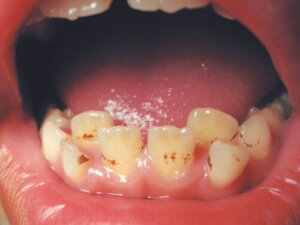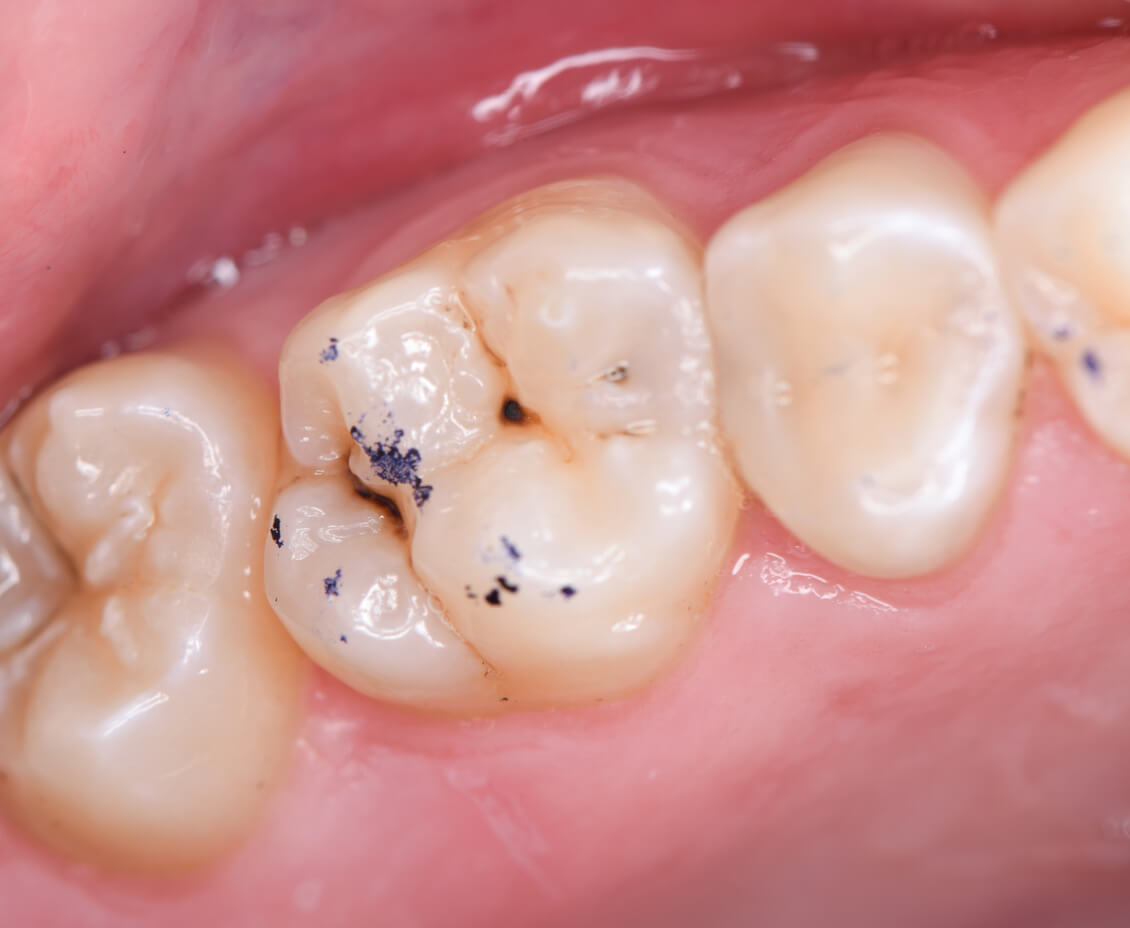Stains on Children's Teeth Due to Iron Supplementation

It’s common for some parents to notice that their children’s teeth no longer look as white as when they first came in. You should know that there’s an association between the appearance of stains on children’s teeth and the use of iron supplements. Here we’ll tell you all about it.
Not all pigmentations on dental elements are associated with poor oral hygiene. This is the case of dark stains on children’s teeth due to the use of iron supplements that some pediatricians recommend to prevent or treat anemia. Keep reading to find out what you can do to reduce this side effect.
Iron supplementation in children
Iron deficiency in children and the resulting anemia are a very common concern in the first years of life. The lack of this mineral could cause a decrease in the physical, mental, and behavioral performance of the child.
There are several factors that can lead to a lack of this micronutrient. Poor absorption or very rapid growth are some examples, although a diet poor in iron is the most frequent cause.
The prevention of this deficiency is a priority for pediatrics in the early stages of the development of children. For this reason, supplementation of the mineral is a very common practice in the early years of children. This product is dark reddish brown in color, is used in liquid form to facilitate its intake, and usually pigments the tooth surfaces.

Why does iron supplementation cause stains on children’s teeth?
You should know that the normal color of children’s teeth isn’t completely white, but rather ivory or yellowish white. But the appearance of the teeth can be affected by the appearance of stains and pigmentations that owe their origin to different factors.
Stains on children’s teeth due to the use of iron supplementation are very frequent during childhood. The contact of the mineral with the tooth’s surface is responsible for the appearance of this esthetic defect. This is due to the fact that the metal is able to bind to the tiny porosities, fissures, or pits of the dental elements. In addition, its combination with chromogenic microorganisms present in the patient’s saliva could favor the formation of black spots on the teeth.
In general, they’re usually observed as a black area in the area where the teeth meet the gum line. They can appear as soon as the medication is used or they can appear over time.
These pigmentations aren’t removed by brushing, but must be cleaned by the pediatric dentist using specific instruments. However, they may reappear after removal if the child continues with the medication.
Although stains on children’s teeth due to iron supplementation may be a cause for concern for parents, they’re harmless. Despite the aesthetic consequence affecting the appearance of the child’s smile, they don’t pose a risk to the dental health of little ones. In addition, with the passing of time, they disappear on their own.
What to do to avoid stains on children’s teeth due to iron supplementation?
If your child’s pediatrician tells you to use iron supplements, you can follow these simple tips below to avoid the appearance of stains on your child’s teeth.
Mixing liquid iron with another beverage
Combining the medication with a small amount of water or juices rich in vitamin C will reduce the contact of the metal with the tooth surface. However, mixing with milk and other dairy products that hinder its absorption should be avoided.
Use straws
If the child is old enough to use straws, the medication can be offered in this way to reduce the contact of the iron with the dental enamel. In the case of infants, one option for administering the liquid is to use a syringe.
Offer iron-rich foods
One way to complement the treatment is to offer the child iron-rich foods such as red meat, legumes, eggs, and green leafy vegetables. In this case, your pediatrician may suggest decreasing the use of supplements, as long as there’s an improvement in hemoglobin levels.

Brushing teeth properly
Brushing children’s teeth properly and frequently can decrease the formation of stains on the teeth. Cleaning after administering iron is one way to reduce the risk of staining.
Have teeth professionally cleaned
In cases where stains have already appeared on children’s teeth due to iron supplementation, a professional cleaning by a pediatric dentist may be necessary. This is done if the age and cooperation of the little one in the dentist’s chair allow it and if the aesthetic needs warrant it.
It’s important to visit the dentist
Stains on the teeth of young children may be due to multiple factors. Food pigments, medications, bacteria, or cavities can be the origin of the color changes.
Taking little ones to a pediatric dentist from an early age allows the professional to determine the cause of these disorders in the appearance of the teeth and act accordingly. Keep in mind that dark stains caused by the use of iron don’t have the same severity as those caused by cavities.
If the stains on children’s teeth are the result of the use of an iron supplement, there’s no reason to worry. With a professional cleaning or simply with the passing of time, these pigmentations can disappear and leave the child with a clean smile.
It’s common for some parents to notice that their children’s teeth no longer look as white as when they first came in. You should know that there’s an association between the appearance of stains on children’s teeth and the use of iron supplements. Here we’ll tell you all about it.
Not all pigmentations on dental elements are associated with poor oral hygiene. This is the case of dark stains on children’s teeth due to the use of iron supplements that some pediatricians recommend to prevent or treat anemia. Keep reading to find out what you can do to reduce this side effect.
Iron supplementation in children
Iron deficiency in children and the resulting anemia are a very common concern in the first years of life. The lack of this mineral could cause a decrease in the physical, mental, and behavioral performance of the child.
There are several factors that can lead to a lack of this micronutrient. Poor absorption or very rapid growth are some examples, although a diet poor in iron is the most frequent cause.
The prevention of this deficiency is a priority for pediatrics in the early stages of the development of children. For this reason, supplementation of the mineral is a very common practice in the early years of children. This product is dark reddish brown in color, is used in liquid form to facilitate its intake, and usually pigments the tooth surfaces.

Why does iron supplementation cause stains on children’s teeth?
You should know that the normal color of children’s teeth isn’t completely white, but rather ivory or yellowish white. But the appearance of the teeth can be affected by the appearance of stains and pigmentations that owe their origin to different factors.
Stains on children’s teeth due to the use of iron supplementation are very frequent during childhood. The contact of the mineral with the tooth’s surface is responsible for the appearance of this esthetic defect. This is due to the fact that the metal is able to bind to the tiny porosities, fissures, or pits of the dental elements. In addition, its combination with chromogenic microorganisms present in the patient’s saliva could favor the formation of black spots on the teeth.
In general, they’re usually observed as a black area in the area where the teeth meet the gum line. They can appear as soon as the medication is used or they can appear over time.
These pigmentations aren’t removed by brushing, but must be cleaned by the pediatric dentist using specific instruments. However, they may reappear after removal if the child continues with the medication.
Although stains on children’s teeth due to iron supplementation may be a cause for concern for parents, they’re harmless. Despite the aesthetic consequence affecting the appearance of the child’s smile, they don’t pose a risk to the dental health of little ones. In addition, with the passing of time, they disappear on their own.
What to do to avoid stains on children’s teeth due to iron supplementation?
If your child’s pediatrician tells you to use iron supplements, you can follow these simple tips below to avoid the appearance of stains on your child’s teeth.
Mixing liquid iron with another beverage
Combining the medication with a small amount of water or juices rich in vitamin C will reduce the contact of the metal with the tooth surface. However, mixing with milk and other dairy products that hinder its absorption should be avoided.
Use straws
If the child is old enough to use straws, the medication can be offered in this way to reduce the contact of the iron with the dental enamel. In the case of infants, one option for administering the liquid is to use a syringe.
Offer iron-rich foods
One way to complement the treatment is to offer the child iron-rich foods such as red meat, legumes, eggs, and green leafy vegetables. In this case, your pediatrician may suggest decreasing the use of supplements, as long as there’s an improvement in hemoglobin levels.

Brushing teeth properly
Brushing children’s teeth properly and frequently can decrease the formation of stains on the teeth. Cleaning after administering iron is one way to reduce the risk of staining.
Have teeth professionally cleaned
In cases where stains have already appeared on children’s teeth due to iron supplementation, a professional cleaning by a pediatric dentist may be necessary. This is done if the age and cooperation of the little one in the dentist’s chair allow it and if the aesthetic needs warrant it.
It’s important to visit the dentist
Stains on the teeth of young children may be due to multiple factors. Food pigments, medications, bacteria, or cavities can be the origin of the color changes.
Taking little ones to a pediatric dentist from an early age allows the professional to determine the cause of these disorders in the appearance of the teeth and act accordingly. Keep in mind that dark stains caused by the use of iron don’t have the same severity as those caused by cavities.
If the stains on children’s teeth are the result of the use of an iron supplement, there’s no reason to worry. With a professional cleaning or simply with the passing of time, these pigmentations can disappear and leave the child with a clean smile.
All cited sources were thoroughly reviewed by our team to ensure their quality, reliability, currency, and validity. The bibliography of this article was considered reliable and of academic or scientific accuracy.
- Zavaleta, N. (2017). Anemia infantil: retos y oportunidades al 2021.
- IPARRAGUIRRE-ALIAGA, H. U. G. O. (2020). CONOCIMIENTOS Y PRÁCTICAS DE MADRES SOBRE PREVENCIÓN DE ANEMIA FERROPENICA EN NIÑOS MENORES DE 5 AÑOS. HOSPITAL REGIONAL DE ICA–2019. Revista Médica Panacea, 9(2), 104-107.
- Zavaleta, N., & Astete-Robilliard, L. (2017). Efecto de la anemia en el desarrollo infantil: consecuencias a largo plazo. Revista Peruana de Medicina Experimental y Salud Pública, 34, 716-722.
- COLQUE HUAMAN, M. B. (2020). ADMINISTRACIIÓN DE HIERRO Y SU INFLUENCIA EN LA PIGMENTACIÓN DE LOS DIENTES EN NIÑOS MENORES DE 36 MESES DEL PUESTO DE SALUD INTIORKO, TACNA 2020.
- REYES, S. A. G., & LARREA, J. F. P. EFECTOS DEL HIERRO SOBRE ESTRUCTURA DENTARIA EN NIÑOS DE 3-10 AÑOS EN EL CENTRO INFANTIL SANTA DOROTEA SEMESTRE A-2017.
- Castro Moncada, M. W. (2021). Pigmentaciones negras exógenas, dentición decidua asociadas a ingesta de sulfato ferroso, niños 2 a 5 años, Centro de Salud Bellavista-Sullana.
- Ron Loayza, S. N. (2021). Alteraciones del color dental por el uso de fármacos (Bachelor’s thesis, Universidad de Guayaquil. Facultad Piloto de Odontología).
- Custodio Hernández, T. G. (2019). Prevalencia de pigmentaciones extrínsecas negras en alumnos de educación inicial de la IE 11003 Karl Weiss, Chiclayo-2019.
- Yarlequé Andrade, S. T. (2017). Evaluación in vitro del grado de adsorción de sulfato ferroso en dientes de bovino a diferentes tiempos de exposición.
This text is provided for informational purposes only and does not replace consultation with a professional. If in doubt, consult your specialist.








